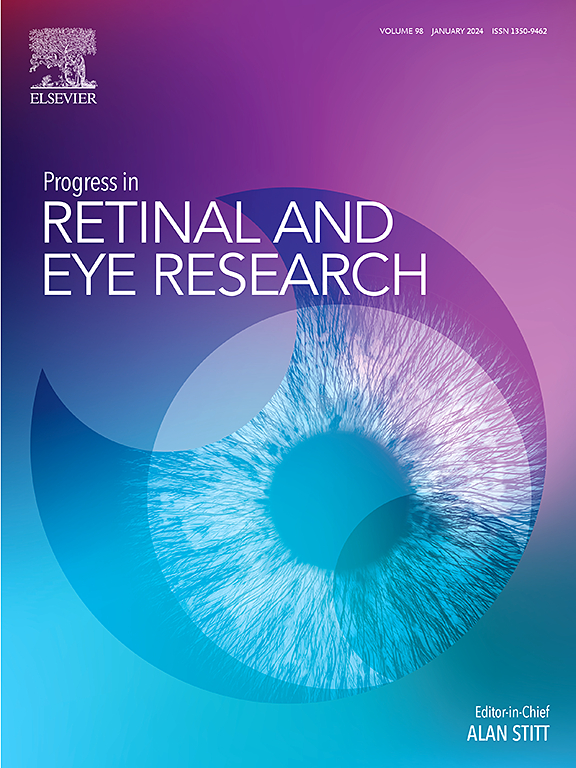A comprehensive scoping review of methodological approaches and clinical applications of tear fluid biomarkers
IF 14.7
1区 医学
Q1 OPHTHALMOLOGY
引用次数: 0
Abstract
Tear fluid is an emerging source of disease biomarkers, drawing attention due to its quick, inexpensive, and non-invasive collection. The advancements in detection techniques enable the measurement of ultra-low biomarker levels from small sample volumes typical of tear fluid. The lack of standardized protocols for collection, processing, and analysis of tear fluid remains a significant challenge. To address this, we convened the Tear Research Network Review Taskforce in 2022 to review protocols from the past three decades, providing a comprehensive overview of the methodologies used in tear fluid biomarker research.
A total of 1484 articles published from January 1974 to May 2024 from two electronic databases, Embase and Ovid MEDLINE, were reviewed. An exponential increase in the number of articles on tear fluid biomarkers was observed from 2015 onwards. The two most commonly reported collection methods were; glass capillaries (45.2%), and Schirmer's strips (25%), with glass capillary tube collection remaining the most frequent method until 2019, when Schirmer's strips became the leading method. Most articles analyzed tear fluid proteins (65%) and focused on a single analyte (32.3%). In recent years, an increase was observed in the type and number of examined analytes.
The differences in the reported methodologies and protocols underscore the need for standardization and harmonization within the field of tear fluid biomarkers to minimize methodological differences and reduce variability in clinical outcomes. Consistent and detailed reporting is essential for improving the reproducibility and validity of tear fluid studies, in order to advance their potential clinical applications.
泪液生物标志物的方法学方法和临床应用的全面范围综述。
泪液是一种新兴的疾病生物标志物来源,因其快速、廉价和无创收集而备受关注。检测技术的进步使得从典型泪液的小样本量中测量超低生物标志物水平成为可能。缺乏收集、处理和分析泪液的标准化方案仍然是一个重大挑战。为了解决这一问题,我们于2022年召集了泪液研究网络审查工作组,对过去三十年的协议进行审查,全面概述泪液生物标志物研究中使用的方法。对1974年1月至2024年5月在Embase和Ovid MEDLINE两个电子数据库中发表的1484篇文章进行了综述。从2015年起,关于泪液生物标志物的文章数量呈指数增长。最常见的两种收集方法是;玻璃毛细管采集(45.2%)和席尔默试纸(25%),其中玻璃毛细管采集一直是最常用的方法,直到2019年,席尔默试纸成为主要方法。大多数文章分析泪液蛋白(65%),集中于单一分析物(32.3%)。近年来,检测分析物的种类和数量都有所增加。所报告的方法和方案的差异强调了泪液生物标志物领域内标准化和协调的必要性,以尽量减少方法差异并减少临床结果的可变性。一致和详细的报告对于提高泪液研究的可重复性和有效性至关重要,以促进其潜在的临床应用。
本文章由计算机程序翻译,如有差异,请以英文原文为准。
求助全文
约1分钟内获得全文
求助全文
来源期刊
CiteScore
34.10
自引率
5.10%
发文量
78
期刊介绍:
Progress in Retinal and Eye Research is a Reviews-only journal. By invitation, leading experts write on basic and clinical aspects of the eye in a style appealing to molecular biologists, neuroscientists and physiologists, as well as to vision researchers and ophthalmologists.
The journal covers all aspects of eye research, including topics pertaining to the retina and pigment epithelial layer, cornea, tears, lacrimal glands, aqueous humour, iris, ciliary body, trabeculum, lens, vitreous humour and diseases such as dry-eye, inflammation, keratoconus, corneal dystrophy, glaucoma and cataract.

 求助内容:
求助内容: 应助结果提醒方式:
应助结果提醒方式:


